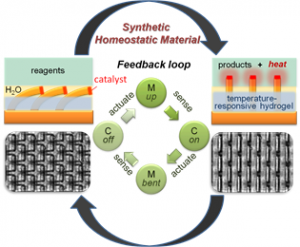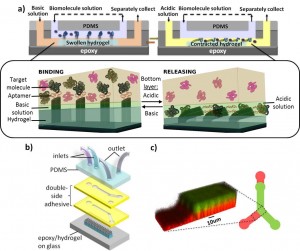Bioinspired Smart Self-regulating Material Systems
Sponsor: Department of Energy
Living organisms exhibit unique homeostatic abilities, maintaining tight control of their local environment through inter-conversions of chemical and mechanical energy and self-regulating feedback loops organized hierarchically across many length scales. Inspired by this, we have applied the concept of homeostasis to the design of autonomous materials and created a synthetic homeostatic material, SMARTS (Self-regulated Mechano-chemical Adaptively Reconfigurable Tunable System), which reversibly transduce external or internal chemical inputs into user-defined outputs via the “on/off” mechanical actuation of catalyst-bearing, hydrogel-driven microstructures. Further exploiting the potential would have transformative impacts in areas ranging from fatigue-reporting or self-healing system that help stabilize functions and prevent failure to smart materials that regulate energy usage.
Harnessing Chemo-mechanical Energy Transduction to Create Systems that Selectively “Catch and Release” Biomolecules
Sponsor: Department of Energy
Inspired by the chemo-mechanically moderated transporting and sorting of specific biological molecules in living systems, we propose to develop biologically-inspired adaptive material systems that harness conversion of chemical and mechanical energy to perform programmable, high-efficiency catch, transport and release of specific biomolecules. To capture the cooperative processes of biomolecular signaling and transport, we will devise a new class of integrated materials that combine chemo-mechanical “smart” components: 1) stimuli-responsive hydrogels, which undergo a volume change in response to external cue, acting as “muscle” and 2) target molecule-specific binding species (such as aptamers, ligands, etc.) that can reversibly change molecular configuration to bind and release targets upon changes in temperature or pH. In such a system, hydrogel can convert chemical energy into mechanical energy by actuating embedded microscopic posts, which carry binding species. When submerged in a bilayer fluid containing a biological mixture, the moving posts bind targets and subsequently transport and release them into a different collecting fluid. This novel system provides efficient routes for a nondestructive, sequential ‘detection-and-separation’ of targets from complex biofluids, without the need for expensive tools or high-energy inputs. These studies will lay foundation for designing systems that translate a small-scale molecular input into a large-scale motion and enable programmable ‘catch and release’ of specific biomolecules, particles and cells. The platform is ideally suited for applications where separation of microliter samples is required for analysis with short turnaround times, such as the capture of contaminants in water or rare cells in body fluid for further studies. These attributes are critical to various chemical and biochemical processes where energy-efficient separations are needed for downstream processing.
Universal Sensing Platform Based on Responsive Hydrogel Interfometer
Sponsor: ASU Start-up Fund
Stimuli-responsive crosslinked polymers, hydrogels can change their volume significantly in response to small alterations of certain environmental parameters. As a network of soft polymers, hydrogel can be chemically adjusted to provide a large assortment of sensitivities as diverse as humidity, temperature, light, mechanical stress, magnetic or electric field, pH, glucose and other molecular species. It is also possible to finely tune the sensitivity and selectivity of each stimulus by tailoring polymer composition or geometry. Due to these properties, many hydrogel-based sensing designs have been developed with high performance demonstrated, including photonic crystals, hydrogel gratings and SPR sensors. Yet it is still challenging to fabricate a hydrogel sensing system that simultaneously satisfies the requirements of cost, robustness, sensitivity and versatility. To fulfill this goal, we’ve developed an interferometry-based hydrogel sensing platform with easy detectable apparent color change. Fast response and high sensitivity have been demonstrated upon 1 µM level of analyte injection in miliseconds. Theoretical mechanical and optical calculation has validated the experimental results and also provides insights for system design and optimization. Compared to other sensing techniques involving hydrogel or responsive polymers, our system doesn’t require complex or expensive fabrication procedure, can work under extreme conditions (e.g. fully dehydrated environment) and allows selectively detection of many analytes by proper gel modifications. We believe that our technique is an important development of externally actuated responsive nanomaterials with wide applications in environment and (bio)medicine.

